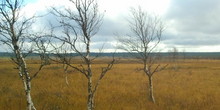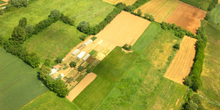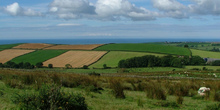Biodiversity
Our Work
Latest in Biodiversity & Land Use
-

Towards sustainability: Future policies for European livestock
The CAP is failing to reward adequately those livestock farmers who produce public goods. Brexit and CAP reform are opportunities to do better.
-
What can the UK do to reduce environmental risks from pesticides?
The UK’s action plan on sustainable use of pesticides aims to reduce the risks and impacts of pesticide use on the environment and encourage alternative approaches and techniques. How is the UK doing?
-
Will Brexit affect the UK’s actions to reduce the environmental impacts of pesticides?
The UK’s action plan on sustainable use of pesticides aims to reduce the impacts of pesticide use on the environment and encourage alternative approaches. How is the UK doing and how could Brexit change the government’s approach to pesticides?
-
Ecological Focus Areas – what are their impacts on biodiversity?
Ecological Focus Areas are intended to safeguard and improve biodiversity on arable farms in the EU. This IEEP study for EEB and BirdLife examined the evidence for potential biodiversity impacts on farmland, taking into account how the areas are being managed.
-
Improving environmental financing via result-based agri-environment measures
A new article by IEEP explores the use of result-based agri-environment measures in the region of Baden-Württemberg, Germany. The study shows that result-based schemes can increase the environmental effectiveness and conditionality of the EU Common Agricultural Policy.
-
New report launch: Call for a new vision for responsible renewable energy with a clear European dimension
Claude Turmes MEP hosted an event launching both IEEP’s report and a debate on the future of renewable energy in Europe. In the our report IEEP present how a resource efficient energy system might be delivered in a way that minimises impact on biodiversity and the wider environment.
-
Nature, Health and Jobs: IEEP at Green Week 2015
Drawing on recent work by the Institute, IEEP’s Patrick ten Brink will present at Green Week 2015 on Jobs & Growth through Green Infrastructure (3 June 2015 - 16:30-18:00, Session 2.2) and on Health and Social Benefits of Nature and Biodiversity Protection (4 June 2015 - 09:30-11:00, Session 3.3).
-
Nature and the green economy – IEEP contributing to China’s eco-civilisation drive
IEEP’s Patrick ten Brink presented on Nature and its Role in the Transition to a Green Economy at the TEEB Multi-stakeholder International Workshop held on 21-22 January in Beijing, China. The talk contributed to current discussions in China on how decision-makers can better consider the multiple values of nature and ecosystems, with a focus on protected areas.
-
The Manual: Chapter 9 - Biodiversity
This is a chapter of IEEP’s Manual of European Environmental Policy. In this chapter the development of the EU biodiversity policy framework is explored, including the Birds and Habitats Directive and other legislation on Genetically Modified Organisms, for example.
-
Time for an updated global agenda for protected areas - IUCN World Parks Congress in Sydney (12 – 19 November)
The landmark international forum on protected areas - IUCN World Parks Congress (WPC) – will take place in in Sydney 12 – 19 November. IEEP’s Marianne Kettunen will be attending the event, showcasing and drawing lessons from IEEP’s longstanding work on protected areas.
-
New guidance for farmland management in Natura 2000
New guidance for farmland management in Natura 2000 gives agricultural and conservation authorities a step-by-step guide to management and funding measures and practical advice on habitat and species management.
-
High Nature Value farming throughout EU-27 and its financial support under the CAP
This study reviews Member States’ estimates of the extent of HNV farmland and use of RDP measures and the CMEF indicators, then identifies future priorities for CAP support for HNV farming and discusses the support opportunities under the reformed CAP. It offers detailed new evidence about the combined effect of Pillar 1 and Pillar 2 CAP payments on the economic and environmental viability of a typical HNV farming system in three Member States.
-
New report: High Nature Value Farming in the EU
Member States need to make the most of the opportunities under the new Common Agricultural Policy if the declines in HNV farming, critical for meeting our 2020 biodiversity targets, are to be halted.
-
Policy Options to Achieve No Net Loss of Biodiversity
A new IEEP led study concludes that mandatory biodiversity offsetting is required to achieve no net loss of biodiversity in the EU, but its introduction could be counter-productive if it is not introduced cautiously and regulated strictly. The first priority should be to better implement existing nature conservation measures.
-
Options for sustainable food and agriculture in the EU
How should Europe respond to the increased demands on our food and agriculture systems arising from global population growth, changing diets, and competing demands on agricultural land? This report offers a view on how the EU could play a role in meeting these challenges in the coming decades and sets out some of the options which merit particular attention.
-
Europe’s role in feeding the world in 2050
IEEP presents views on how Europe should respond to the increased demands on our food and agriculture systems arising from global population growth, changing diets, and competing demands on agricultural land.
-
Interactions between climate change and agriculture; and between biodiversity and agriculture in Europe
What should be Europe’s role in feeding the world in 2050? This IEEP report for the European Parliament describes options for increasing the productivity of European agriculture whilst adapting to climate change, reducing emissions, and providing biodiversity and ecosystem service benefits from agriculture.
-
Recycling wastes and residues for sustainable bioenergy and biomaterials
What should be Europe’s role in feeding the world in 2050, considering competing demands for land? This IEEP report for the European Parliament describes options for reusing food wastes and agricultural and forestry residues for biomaterials and bioenergy.
-
Ecosystem services of boreal mires and peatlands in Finland
Mire ecosystems are well-known for their unique species and habitats of high conservation value and they also provide a range of benefits to our societies and economies. This publication outlines the results of a pioneering project that aimed to identify and valuate ecosystem services provided by pristine mires and managed peatlands in Finland.
-
Guidance manual for TEEB country studies - Version 1.0
Co-authored by IEEP staff, the Manual is for anyone who is considering or currently undertaking a TEEB country study. Its purpose is to provide guidance throughout the entire TCS cycle, from initiation to policy analysis and ecosystem service valuations, communicating findings, and using results to support decision making.
Highlights
-
Options for sustainable food and agriculture in the EU
How should Europe respond to the increased demands on our food and agriculture systems arising from global population growth, changing diets, and competing demands on agricultural land? This report offers a view on how the EU could play a role in meeting these challenges in the coming decades and sets out some of the options which merit particular attention.
-
Biodiversity proofing of the EU budget
This study shows how more can be done to firstly avoid and minimize detrimental impacts of EU funding on biodiversity, and secondly to increase biodiversity benefits.
-

Ecosystem services of boreal mires and peatlands in Finland
-

Land use mapping for sustainable biofuels
-

Exploring key priorities and actions for the 7th EAP
-

Addressing the EU’s biodiversity goals through the CAP
